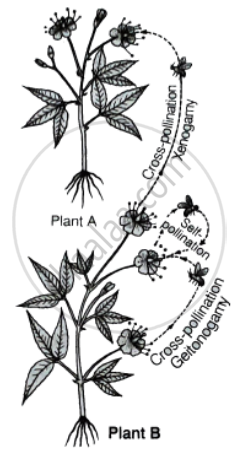Advertisements
Advertisements
प्रश्न
What are the possible types of pollinations in chasmogamous flowers. Give reasons.
उत्तर
There are two types of pollinations (chasmogamy) in chasmogamous flowers, i.e., self-pollination and cross-pollination.
- Self-pollination(Autogamy) The transfer of pollen grains from another to stigma of the same flower is called self-pollination. It is found in both cleistogamous and chasmogamous flowers.
- Cross-pollination (Allogamy) The transfer of pollen grains from anther to the stigma of another flower is called cross-pollination. It is of two types
- Geitonogamy it is the transfer of pollen from another to the stigma of another flower of the same plant. It is functionally a type of cross-pollination involving a pollination agent, genetically. It is similar to autogamy.
- Xenogamy The transfer of pollen grains from the flower of one plant to the stigma of another plant. This is the only type of pollination, which brings genetically different types of pollen grains to the stigma.

Showing self-pollination and cross-pollination
APPEARS IN
संबंधित प्रश्न
Entamophily is
State true or false. If false, correct the statement.
The transfer of pollen to the stigma is known as pollination.
Which of the following is important for self-pollination?
In ______, both autogamy and geitonogamy are prevented.
The receptive part in the flower receives ______ in the process of pollination in angiosperms.
Which of the following pollinating agent is involved in chiropterophily?
Identify the CORRECT statements about self-pollination.
- Self-pollination is the most economic method for plant modification.
- Genetic stability can be maintained in the progeny through self-pollination.
- Undesirable characters can be eliminated through self-pollination
- Continued self-pollination may result in the less viable seeds.
- Self-pollination favours evolution.
Explain the difference between self-pollination and cross-pollination.
Match the following:
| Pollen | a. | anther |
| Ovule | b. | protection |
| stamen | c. | Powdery |
| Sepal | d. | Seed |
Pollination in closed flowers is designated as ______.
